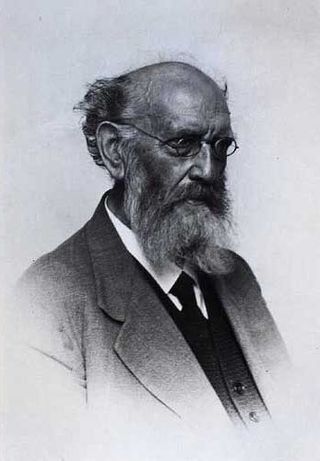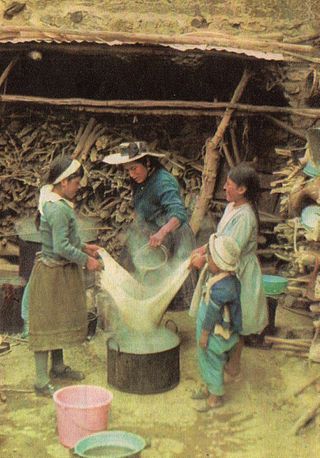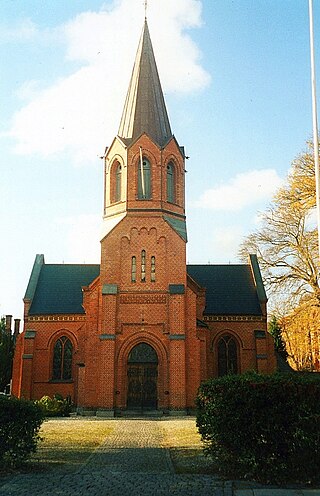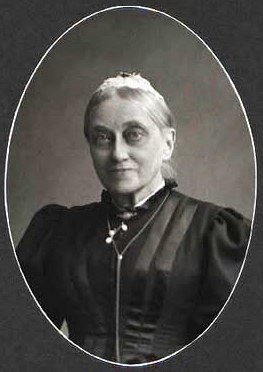Related Research Articles

Carl Christian Hillman Jacobsen was a Danish brewer, art collector and philanthropist. Though often preoccupied with his cultural interests, Jacobsen was a shrewd and visionary businessman and initiated the transition of the brewery Carlsberg from a local Copenhagen brewery to the multinational conglomerate that it is today.

Ernst Henrich Berling was a German-Danish book printer and publisher. From 1749 he published Danske Post Tidender, which would later become Berlingske Tidende.

Carl Julius Aller was a Danish publisher of the late 19th and early 20th century and founder of Aller Media, the largest publisher of weekly magazines in the Nordic countries and still controlled by the Aller family.

Johan Frederik Schultz was a Danish book printer and publisher.

Women have been active in brewing since ancient times. From the earliest evidence of brewing in 7000 BCE, until the commercialization of brewing during industrialization, women were the primary brewers on all inhabited continents. In many cultures, the deities, goddesses and protectors of brewers were female entities who were associated with fertility.

Anna Magdalena Godiche née Høpfner was a Danish book printer and publisher. She managed the biggest printing company in contemporary Denmark.

St. Andrew's Church is a Roman Catholic church in Ordrup, Gentofte Municipality, Copenhagen, Denmark.

The Women's Exhibition from the Past and Present held in Copenhagen in 1895 was an art and culture exhibition for women from the Nordic countries. Inspired by the 1893 World's Fair in Chicago, it was designed to demonstrate how far Nordic women had advanced in the areas of education, employment and art. The first of its kind in Europe, it was considered a great success.

Badstuestræde 18 is a Neoclassical property in Badstuestræde in the Old Town of Copenhagen, Denmark, constructed for brewer Peter Møller as part of the rebuilding of the city following the Copenhagen Fire of 1795. It was listed in the Danish registry of protected buildings and places in 1918. Notable former residents include the philologist Jacob Baden, actor Peter Jørgen Frydendahl, ballet master Carl Dahlén, actress and opera singer Johanna Elisabeth Dahlén and later ballet master of the Royal Swedish Ballet, Sigurd Harald Lund.
Johan Rudolph Thiele was a Danish book printer. He founded a successful printing business in Copenhagen in 1771 which was later continued as H. H. Thiele by his son Hans Henrik Thiele. The company survived until 1937. Another son, Frederik Anton Thiele, founded N. A. Thiele, a manufacturer and retailer of scientific instruments which would later develop into one of Denmark's leading chains of retail opticians under the name Thiele. A third son was the art historian and writer Just Mathias Thiele.

Niels Hemmingsens Gade 32 is a historic building in the Old Town of Copenhagen, Denmark. It was built in the first half of the 1740s. A brewery was for more than one hundred years operated in a rear wing. Brødrene Cloëtta, one of Denmark's leading chocolate manufacturers of its day, was based in the building from 1865 until 1901. The three-winged building complex was listed on the Danish registry of protected buildings and places in 1981. A gilded Neptune figure is seen above the gateway and the keystone features the names of the first owners. Notable former residents include the naval officers Poul de Løvenørn and Peter Nicolay Skibsted, the businessman Conrad Hauser and the linguist Rasmus Rask.
Marie Martine Bonfils (1731-1804) was a Danish businessperson.

Bianco Luno was a Danish book printer. His printing business, Bianco Lunos Bogtrykkeri, was at the time of his death in 1852 the largest company of its kind in Denmark. The street Bianco Lunos Allé in Frederiksberg is named after him.
Margrethe (Grethe) Glad née Axelholm (1891–1990) was a Danish socialite, fashion designer and educator. In 1931, she established a fashion and design school in Copenhagen, originally known as Margrethe-Skolen but now renamed the Scandinavian Academy of Fashion Design. During and after the Second World War she became active in charity work both in Denmark and France. She continued to fund charities by selling dolls dressed in historical costumes to museums in the United States and Europe. From 1977, for several years she headed the family firm L.C. Glad & Co..

The Gyldenfeldt House is a Neoclassical property situated at the corner of Brolæggerstræde and Knabrostræde in the Old Town of Copenhagen, Denmark. It was like many of the other properties in the area constructed after the Copenhagen Fire of 1795. A brewery in the courtyard was for a while leased by Chresten Jacobsen, father of J.C. Jacobsen, prior to his acquisition of Bo. 5 on the other side of the street. The building complex was listed on the Danish registry of protected buildings and places in 1950.
Jens Lind was a Danish sea captain, ship-owner, merchant, slave trader, landowner and industrialist. He was from the late 1780s until 1806 active in the Triangle Trade and was as such responsible for the shipment of somewhere between 1,800 and 2,000 slaves from Guinea to the Danish West Indies, approximately half of them illegally after the abolition of the trans-atlantic slave trade in 1803. He was from around 1800 also involved in a substantial number of industrial enterprises, including a brewery at Vandkunsten 8 in Copenhagen and a paper mill, oil mill and soap factory on the Hulemose estate at Vordingborg.

Christine Dorothea Michelle Elfride Fibiger née Müller (1832–1911) was a Danish writer and philanthropist. She first published a successful cookbook in 1871; then, after her hustand's death in 1873, she supplemented her income by writing a series of novels and short stories, all in support of women's emancipation. These included Askepot (1880) and Præst og Læge (1890). In 1882, she was behind the establishment of a cooking school in Copenhagen, later known as Kjøbenhavns uddannelsesskole for tjenestepiger og vordende husmødre, which she ran until 1889. Her later writings supported vocational opportunities for women, receiving recommendations from government ministries and professional associations. Her memoirs were published posthumously.

Knabrostræde 19 is a Neoclassical property situated at the corner of Knabrostræde and Kompagnistræde in the Old Town of Copenhagen, Denmark. It was constructed by Johan Martin Quist as part of the rebuilding of the city following the Copenhagen Fire of 1795. The building was listed in the Danish registry of protected buildings and places in 1918. Comedy Zoo, Copenhagen's leading comedy club, is based in the building. Notable former residents include the musician and composer Ivar Bredal and the architectural painter Niels Bredal.

Kompagnistræde 20 is a Neoclassical building complex situated at the corner of Kompagnistræde and Knabrostræde in the Old Town of Copenhagen, Denmark, constructed in 1796–97 as part of the rebuilding of the city following the Copenhagen Fire of 1795. A brewery was for more than 200 years, from at least the late 1640s until the 1860s, operated on the site. The building complex comprises a residential corner building as well as an adjacent warehouse at Knabrostræde 16 and another warehouse in the courtyard. The entire complex was listed in the Danish registry of protected buildings and places in 1945. Notable former residents include the government official Jacob Gude, civil servant and later Minister of Interior Affairs I.J. Unsgaard and painter and photographer Edvard Valdemar Harboe.
References
- ↑ Gold, Carol, 1942- (2018). Women in business in early modern Copenhagen : 1740-1835. Museum Tusculanum. ISBN 978-87-635-4597-6. OCLC 1038577313.
You can help expand this article with text translated from the corresponding article in Swedish. (January 2020)Click [show] for important translation instructions.
|